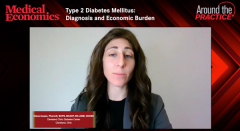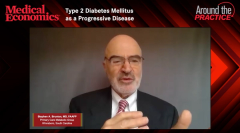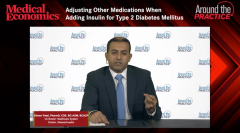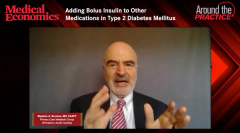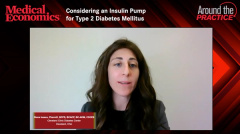
Pathophysiology of Type 2 Diabetes Mellitus
Episodes in this series

Stephen A. Brunton, MD, FAAFP, describes the evolving thoughts on pathophysiology of type 2 diabetes mellitus.
Dhiren Patel, PharmD, CDE, BC-ADM, BCACP: Welcome to this Medical Economics® Around the Practice program titled “Insulin Therapy in Type 2 Diabetes.” I am Dhiren Patel, an adjunct associate professor of pharmacy practice at the Massachusetts College of Pharmacy in Boston, Massachusetts and an endocrine clinical pharmacy specialist at the VA [Veterans Affairs] Boston Healthcare System.
Joining me in this discussion are Dr Stephen A. Brunton, a family physician and the executive director of the Primary Care Metabolic Group in Charlotte, North Carolina, and the editor in chief of the ADA’s [American Diabetes Association’s] primary care journal, Clinical Diabetes; Dr Bob Busch, the director of clinical research and a practicing endocrinologist at Albany Medical College Faculty Practice in Albany, New York; and Diana Isaacs, a clinical pharmacy specialist and the continuous glucose monitoring program coordinator at the Cleveland Clinic Diabetes Center in Cleveland, Ohio. Welcome, everyone. Let’s begin.
Stephen A. Brunton, MD, FAAFP: Thank you.
Robert Busch, MD: Thanks.
Dhiren Patel, PharmD, CDE, BC-ADM, BCACP: Dr Brunton, before we dive into talking about insulin therapy and type 2 diabetes, could you start us off and walk us through a bit about the pathophysiology of type 2 diabetes?
Stephen A. Brunton, MD, FAAFP: You probably led off with me because I’m obviously the oldest person here. It’s been a real evolution in our understanding of the pathophysiology. We initially focused on the beta cell and thought that it was all just about how there was not enough insulin being produced by the pancreas and by the beta cell. Our attention then started turning more to insulin resistance and how, in fact, there was not enough insulin being produced to overcome the resistance that we’re seeing, so you eventually see a decline in the beta cell because it’s unable to maintain and overcome the resistance. We started to see a rise in postprandial glucose as an effect of that.
We now understand that there are a number of different pathophysiological core defects. It’s probably Ralph DeFronzo who first came out with a fantastic lecture in 2008 that talked about the ominous octet. I’ll talk about it in a second, but we are thinking that there are probably way more than 8 defects. There are probably either the egregious 11, or some people say that there are 18 different defects. As our understanding changes, we’ll be looking at what is really going on. It’s a complex issue. The ominous octet though probably gives us the best understanding of the pathophysiology.
We start with the pancreas, and we’ve got the alpha cell as well as the beta cell. There’s too much glucagon being produced. We still have the periphery with the muscle and insulin resistance, but then we also have to look at the fat. The metabolism is occurring, so we get increased free fatty acids that worsen insulin resistance. We look at the kidney. The kidney has much more focus in terms of increased glucose reabsorption. We then look at the intestines and the intestines’ role in terms of incretin production; even incretin resistance is part of it. We then of course have the brain where there may be a decrease in thalamic signal. Frankly, we have 8 core defects that we understand right now.
Dhiren Patel, PharmD, CDE, BC-ADM, BCACP: That makes sense. On the comment you made earlier about the ominous octet evolving, we’re hearing more about the microbiome in the gut. There are so many things that we don’t understand, but we definitely know that there are a lot of patients who have diabetes here in the US [United States]. It may be over 30 million. If we look at the pipeline of people with prediabetes, then there may be another 86 million.
Newsletter
Stay informed and empowered with Medical Economics enewsletter, delivering expert insights, financial strategies, practice management tips and technology trends — tailored for today’s physicians.

